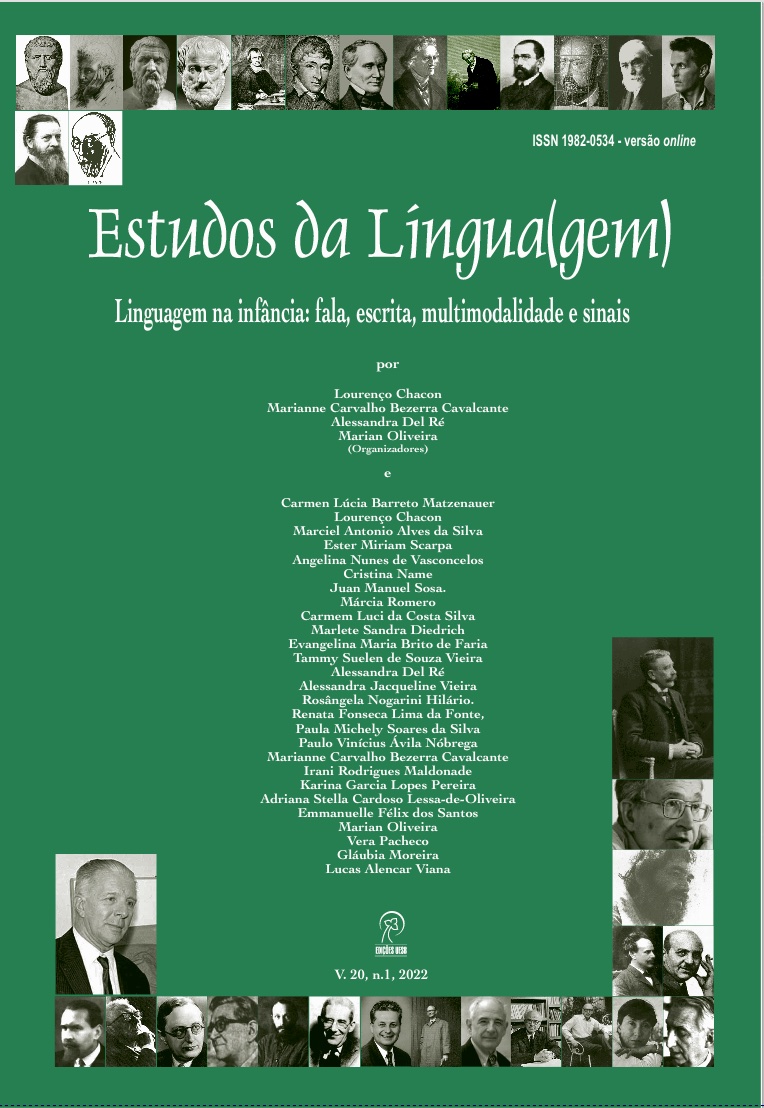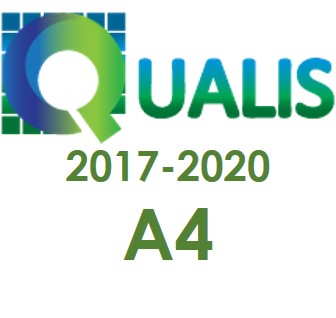Prosodia y funciones discursivas de las interrogativas en el habla dirigida al niño
DOI:
https://doi.org/10.22481/el.v20i1.12066Palabras clave:
Discurso dirigido al niño; Preguntas; Prosodia; Funciones discursivas; Adquisición del lenguaje.Resumen
Investigamos las interrogativas en el habla dirigido al niño, por adultos interactuando con bebés brasileños. Recolectamos datos de cuatro bebés (4 a 12 meses) y sus cuidadores y caracterizamos las preguntas en sus aspectos prosódicos y funciones discursivas. Descubrimos que la mayoría de las preguntas estaban marcadas por uno o más rasgos prosódicos. Inicialmente, las preguntas buscan involucrar al bebé, son retóricas y prominentes. A los seis meses aumentan las semi-retóricas, que apuntan a verificar la comprensión. A los diez meses, las preguntas completas, que buscan nueva información y respuestas claras, se incrementan. Los resultados sugieren que las funciones interrogativas se correlacionan de la capacidad del bebé para dialogar con el adulto, y que la prosodia juega un papel importante a la hora de resaltar las distinciones entre los enunciados e intenciones del adulto, potenciando la capacidad cognitiva, lingüística, afectiva y social del bebé y su desarrollo social.
Descargas
Citas
BARBOSA, P. G. Características da fala materna e suas implicações para a aquisição inicial do vocabulário. 2013. 72f. Dissertação de Mestrado em Psicologia, Universidade Federal de Minas Gerais, Belo Horizonte, 2013.
BOERSMA, P; WEENINK, D. Praat: doing phonetics by computer [Computer program]. Versão 6.1.08. Disponível em http://www.praat.org. Download realizado em setembro de 2019.
BRAUN, B., DEHÉ, N.; NEITSCH, J.; WOCHNER, D.; ZAHNER, K. The prosody of rhetorical and information-seeking questions in German. Language and Speech, v. 62, n. 4, p. 779-807, 2018.
BRENTARI, D.; FALK, J.; WOLFORD, G. The acquisition of prosody in American Sign Language. Language, v. 91, n. 3, p. e144-e168, 2015. DOI: 10.1353/lan.2015.0042.
CAVALCANTE, M. C. B. Da voz à língua: a prosódia materna e o deslocamento do sujeito na fala dirigida ao bebê. 1999. 239f. Tese de Doutorado em Linguística, Universidade Estadual de Campinas, Campinas, 1999.
CAVALCANTE, M. C. B.; BARROS, A. T. M. Manhês: Qualidade vocal e deslocamentos na dialogia mãe-bebê. Veredas Revista de Estudos Linguísticos, v. especial, p. 25-39, 2012.
CHIANG, C.; GEFFEN, S; MINTZ, T. Distinguishing questions and statements using sentence-initial prosodic cues. In: BERTOLINI, A. B.; KAPLAN, M. J. (Eds.) Proceedings of the 42nd Annual Boston University Conference on Language Development. Somerville, MA: Cascadilla Press, 2018. p. 153-158.
COOPER, R.; ASLIN, R. Preference for infant-directed speech in the first month after birth. Child Development, v. 61, n. 5, p. 1584-1595, 1990.
DADALTO, E.; GOLDFELD, M. Características do maternalês em duas crianças de idades distintas. Distúrbios da Comunicação, v. 18, n. 2, p. 201-208, 2006.
DE PABLO, I; MURILLO, E.; ROMERO, A. The effect of infant-directed speech on early multimodal communicative production in Spanish and Basque. Journal of Child Language, v. 47, p. 457-471, 2020.
DEHÉ, N.; BRAUN, B. The prosody of rhetorical questions in English. English Language and Linguistics, p. 1-29, 2019. DOI: https://doi.org/10.1017/S1360674319000157.
FERNALD, A. Human maternal vocalizations to infants as biologically relevant signals: An evolutionary perspective. In BARKOW, J.; COSMIDES, L.; TOOBY, J. (Eds.) The adapted mind. Evolutionary psychology and the generation of culture. Nova York: Oxford Univ. Press, 1992. p. 391-428.
FERNALD, A.; TAESCHER, T.; DUNN, J.; PAPOUSEK, M.; BOYSSON-BARDIES, B. D.; FUKUI, I. A cross-language study of prosodic modifications in mothers’ and fathers’ speech to preverbal infants. Journal of Child Language, v. 16, p. 477-501, 1989.
FROTA, S.; BUTLER, J.; VIGÁRIO, M. Infant’s perception of intonation: Is it a statement or a question? Infancy, v. 19, n. 2, p. 194-213, 2014. DOI: https://doi.org/10.1111/infa.12037.
FUKS, O. Multimodal motherese in Israeli sign language. TISLR13, 2019. DOI: 10.13140/RG.2.2.30585.42081.
GARNICA, O. K. Some prosodic and paralinguistics features of speech to young children. In: SNOW, C. E; FERGUSON, C. A. (Eds). Talking to children: Language input and acquisition. Cambridge: Cambridge University Press, 1977. p. 63-88.
GEFFEN, S.; MINTZ, T. Prosodic differences between declaratives and interrogatives in infant-directed speech. Journal of Child Language, v. 44, p. 968-994, 2017.
GOMES DA SILVA, C.; CARNAVAL, M.; MORAES, J. A. Atos de fala diretivos em português e em espanhol: uma análise acústica comparativa. Entrepalavras, v. 10, n. 1, p. 326-345, 2020. DOI: http://dx.doi.org/10.22168/2237-6321-11751.
KALASHNIKOVA, M.; KEMBER, H. Prosodic cues in infant-directed speech facilitate young children’s conversational turn predictions. Journal of Experimental Child Psychology, v. 199, p. 1-16, 2020. DOI: https://doi.org/10.1016/j.jecp.2020.104916.
MORAES, J. A. A entoação modal brasileira: fonética e fonologia. Cadernos de Estudos Linguísticos, n. 25, p. 101-111, 1993. DOI: https://doi.org/10.20396/cel.v25i0.8636887.
MORAES, J. A. The pitch accents in Brazilian Portuguese: analysis by synthesis. In: BARBOSA, P.; MADUREIRA, S.; REIS, C. (Eds.) Proceedings of Speech Prosody 2008. Campinas: LBASS, 2008. p. 389-397.
MORAES, J. A.; COLAMARCO, M. Você está pedindo ou perguntando: uma análise entonacional de pedidos e perguntas no português do Brasil. Revista de Estudos Linguísticos, v. 15, n. 2, p. 113-126, 2007.
NAME, C.; SOSA, J.M. Cadê o amor da mamãe? As interrogativas na fala dirigida à criança adquirindo o PB. Veredas Revista de Estudos Linguísticos, v. 24, n. 1, p. 72-93, 2020.
NARAYAN, C.; McDERMOTT, L. Speech rate and pitch characteristics of infant-directed speech: Longitudinal and cross-linguistic observations. The Journal of the Acoustical Society of America, v. 139, p. 1272-1281, 2016. DOI: https://doi.org/10.1121/1.4944634.
NASATAKA, N. Motherese in a signed language. Infant Behavior and Development, v. 15, n. 4, 453-460, 1992.
NEWPORT, E. Motherese: the speech of mothers to young children. In Castellan, N. J.; Pisoni, D. B.; Potts, G. R. (Eds). Cognitive theory. Vol. 2. Hillsdale: Lawrence Erlbaum Ass., 1977. p. 177-217.
NIELSEN, N.M. Expanding Searle’s analysis of interrogative speech acts: a systematic classification based on preparatory conditions. Scandinavian Studies in Language, v. 11, n. 1, p. 7-19, 2020.
NUNES, V. A prosódia de sentenças interrogativas totais nos falares catarinenses e sergipanos. 2015. 563f. Tese de Doutorado em Linguística, Universidade Federal de Santa Catarina, Florianópolis, 2015.
PESSÔA, L.; MOURA, M. L. Fala maternal dirigida à criança em cenários comunicativos específicos: um estudo longitudinal. Psicologia: Teoria e Pesquisa, v.2, n.4, p. 439-447, 2011.
RÄSÄNEN, O.; KAKOUROS, S.; SODERSTROM, M. Is infant-directed speech interesting because it is surprising? Linking properties of IDS to statistical learning and attention at the prosodic level. Cognition, v. 178, p. 193-206, 2018. DOI: 10.1016/j.cognition.2018.05.015
SAINT-GEORGES, C.; CHETOUANI, M.; CASSEL, R.; APICELLA, F.; MAHDHAOUI, A.; MURATORI, F.; LAZNIK, M.-C.; COHEN, D. Motherese in interaction: At the cross-road of emotion and cognition? (A systematic review). PLoS One, v. 8, n. 10, p. e78103, 2013. DOI: https://doi.org/10.1371/journal.pone.0078103.
SEARLE, J. R. Speech Acts: An Essay in the Philosophy of Language. Oxford: Cambridge University Press, 1969. 226p.
SILVA, I. S.; NAME, C. A sensibilidade de bebês brasileiros a pistas prosódicas de fronteiras de sintagma entoacional na Fala Dirigida à Criança. Letrônica, v. 7, n. 1, p. 4-25, 2014. DOI: https://doi.org/10.15448/1984-4301.2014.1.16855.
SILVA, C. R.; SANTOS, J. C. L. Perguntas retóricas: entre a gramaticalização e a discursivização. Veredas Revista de Estudos Linguísticos, v. 19, n. 2, p. 248-268, 2015.
SNOW, E. C. Mothers’ speech research: from input to interaction. In: SNOW, C. E; FERGUSON, C. A. (Eds). Talking to children: Language input and acquisition. Cambridge: Cambridge University Press, 1977. p. 31-49.
SNOW, E. C. Issues in the study of input: Finetuning, universality, individual and developmental differences, and necessary causes. In: FLETCHER, P.; MACWHINNEY, B. (Eds.) The Handbook of Child Language. Cambridge, MA: Blackwell, 1995. p. 180-193.
SODERSTROM, M.; BLOSSOM, M.; FOYGEL, R.; MORGAN, J. Acoustical cues and grammatical units in speech to to preverbal infants. Journal of Child Language, v. 35, n. 4, 869-902, 2008.
SOLEY, G.; SEBASTIAN-GALLES, N. Infants’ expectations about the recipients of infant-directed speech. Cognition, v. 198, 104214, p. 1-9, 2020. DOI: https://doi.org/10.1016/j.cognition.2020.104214.
SPLENDORE, K.; CONSTANTINI, A. C.; DA SILVA, K. C. Investigação da prosódia e da linguagem na interação mãe-bebê. Working Papers em Linguística, v. 20, n. 1, p. 172-188, 2019. DOI: https://doi.org/10.5007/1984-8420.2019v20n1p172.
SUNDARA, M.; MOLNAR, M.; FROTA, S. The perception of boundary tones in infancy. Proceedings of the 18thInternational Congress of Phonetic Sciences. 2015.
THORSON, J.; BORRAS-COMES, J.; CRESPO-SENDRA, V.; VANRELL, M.; PRIETO, P. The acquisition of melodic form and meaning in yes-no interrogatives by Catalan and Spanish children. Probus, v. 27, n. 1, p. 73-99, 2014. DOI: https://doi.org/10.1515/probus-2013-0019.
WEPPELMAN, T. L.; BOSTOW, A.; SCHIFFER, R.; ELBERT-PEREZ, E.; NEWMAN, R. S. Children’s use of the prosodic characteristics of infant-directed speech. Language and Communication, v. 23, n.1, p. 63-80, 2003.
Descargas
Publicado
Cómo citar
Número
Sección
Licencia

Esta obra está bajo una licencia internacional Creative Commons Atribución 4.0.

Estudos da Língua(gem) está bajo una Licencia Creative Commons Atribución 4.0 Internacional.
Los autores que publican en el periódico Estudios de la Lengua (g) concuerdan con los siguientes términos:
La revista Estudios del Lenguaje mantiene los derechos de autor de las contribuciones publicadas. Estos derechos incluyen la publicación de la contribución y pondrá a disposición su contenido gratuitamente a través del portal







